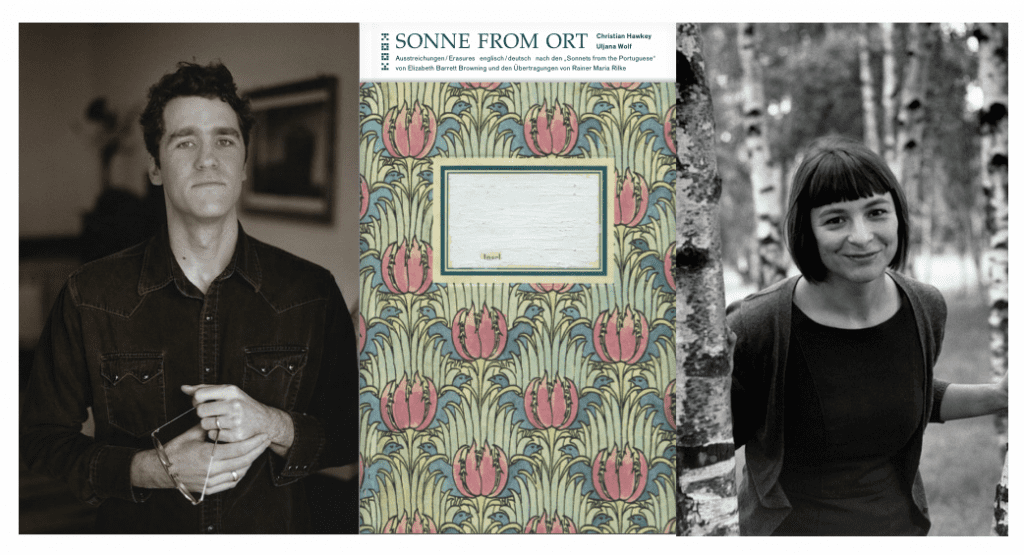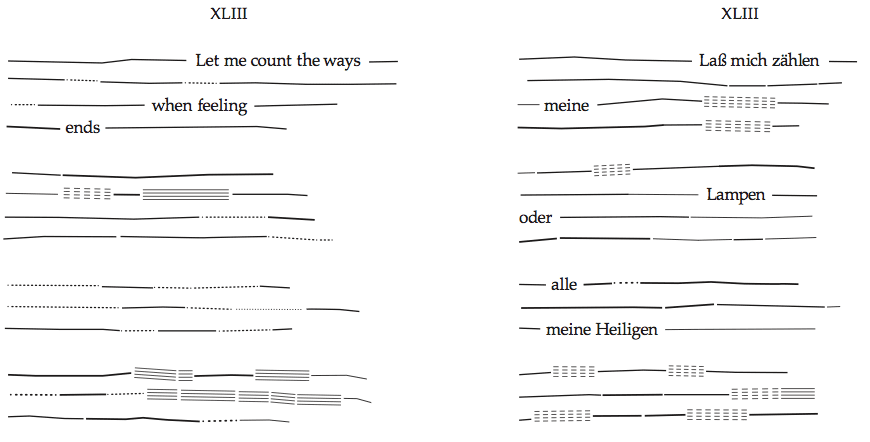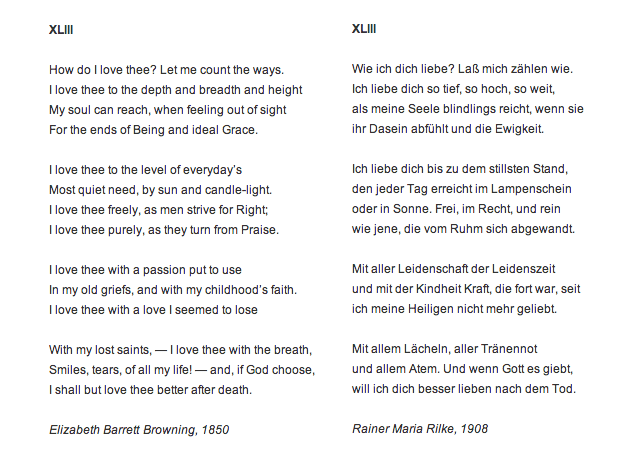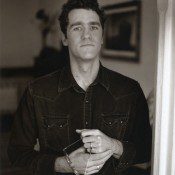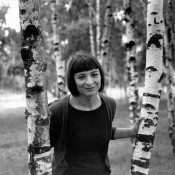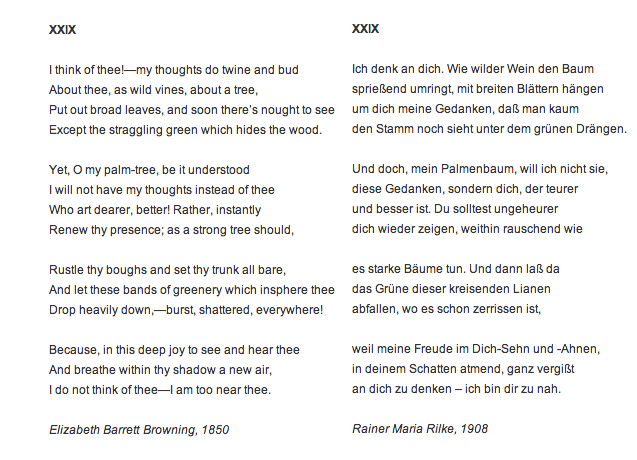Sonne from Ort, Reviewed by Joshua Weiner
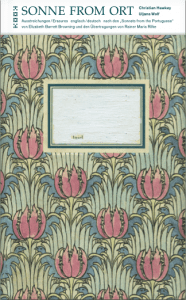
By Christian Hawkey and Uljana Wolf
Kookbooks, 2013
In the Age of Theory, which (please god) we may have passed through by now, the subject of translation was about as rich a manure pile as you could’ve stepped in. And if translation hadn’t already existed as a practice, post-structuralists would’ve had to have invented it. For however the distance between a work and its translation into another language are bridged, the two shores never meet, even if their mutual geographies are only a spitting distance apart: two continents, one having split off from the other, with indeterminate drift. In this way, a work and its translation are analogous to the abyssal situation between a thing and its word. Thus, translation creates another layer of uncertainty, exacerbating the arbitrariness of linguistic relations. And that’s not a theory; it’s a fact. Actually, it’s a theorist’s wet dream. As if reading weren’t already hard enough….
Still, a relationship exists, and our need to extend our connection to others inspires great translations. Great translators are writers who have fallen in love with a work in another language, and through ardor and erudition attempt to consummate their love in another bed of their own making. But there’s never any true touching; rather it’s a kind of zero-gravity dance in which the partner following mimics the actions of the lead partner. They resemble each other yet their differences remain absolute.
Translation can also serve as a kind of mask, the persona of one writer donned by another. The excitement of expressing new feelings and ideas through the vocal adoption of a source work in another language is inspiring—you are suddenly saying things you could never say before.
Between 1845 and 1846, Elizabeth Barrett Browning translated 44 sonnets from the Portuguese, traditional love poems written in another language that she carried over into English. Um, check that. In fact, as we’ve known almost from the beginning, Sonnets from the Portuguese are original (mostly Petrarchan) sonnets that Barrett Browning wrote to Robert Browning during their courtship. Unlike some famous poetic hoaxes that were popularly misconstrued in the 18th century (mostly in the form of epic), Sonnets from the Portuguese tapped into a genuine lyric feeling that Barrett Browning spun with terrific skill into one of the most popular poetic works in English. While the other impersonations are now little more than academic curiosities, Sonnets from the Portuguese has never been out of print.
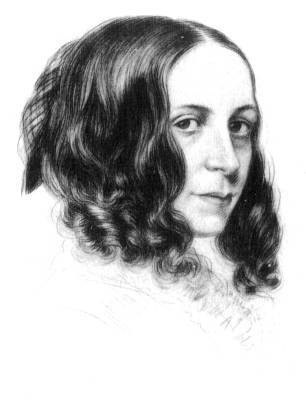
Barrett Browning’s work wasn’t a hoax. In response to a real situation, she adopted a vocal mask of her own invention to express native feelings perhaps otherwise inhibitive. Of course, there is also the added charm of the appealingly exotic — they are not, for example, Sonnets from the Bosnian, the first title she considered before Robert Browning suggested the one we now know, with its more cultured sense of Romance associated with a language, as they say, of the heart. (“My little Portuguese” was also Robert Browning’s pet name for her.) This may strike some readers with a fragrance of pastiche, and there’s more than an element of kitsch in the weave. Barrett Browning’s sonnets are elevated, allegorical, passionate, agonized; they have the sound and they elaborate on the conceits with which readers of poetry remain familiar. And these qualities have often appealed to poets of other tongues, Rainer Maria Rilke being one, who called the sequence “one of the great bird calls of the heart in the landscape of love,” translating them into German in an edition published by Insel Verlag in 1908. (—There is something just a little kitschy, too, running through Rilke, that one detects in his art-love, chrysanthemums, and unicorns . . . The Santa Claus of Loneliness, W.H. Auden called him!)
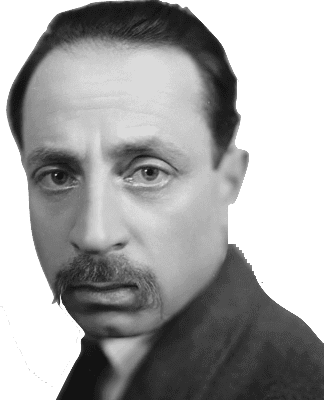
When Sonnets from the Portuguese, written originally in the language of Victorian England, was carried over by Rilke into early twentieth century German, it crossed several borders at once: linguistics, nation/culture, gender, time. Fast forward through international modernism, two world wars, a divided Germany, the revolutions of 1968, Vietnam, postmodernism…. Welcome to 2013, and the publication of Sonne from Ort, an erasure project conducted by U.S. poet, Christian Hawkey (b. 1969) and German poet, Uljana Wolf (b. 1979), a married couple with a new baby and a new co-authored book — the record of their own courtship, perhaps? —transmitted through the mirroring process of translation and erasure — a method of redacting some words in an original work while leaving others, in this case to reveal hidden alternative lyrics embedded in the highly wrought finished poems we already know well from generations of reading. The title, Sonne from Ort, emerges from the original by virtue of an erasing. The new title, with its mix of German and English, translates loosely as Sun from Place (or Location, Site, a specific spot); “ort” is also Middle English for something like “leftover,” and the essential derivative nature of erasure keeps that meaning active, too (not to mention the homonym, always visible, of son).
Erasure projects can smack of preciosity, instilling a false new value into an old thing we were never really interested in to begin with — for example, taking an old obsolete book and, by erasing or covering over some portion of text, revealing a new boring work lurking inside the dull original. But when Tom Phillips picked up an obscure Victorian novel back in 1966, and then altered every page of it by painting around words and phrases, he created, by virtue of connecting disparate syntactic units, new associations, in a sense thereby creating an entirely new narrative, in a new way. Not only that, the painting itself is brilliant, matching the cut-up of printed text with startlingly fresh colorful patterns and designs that complement the affect of carving out new sinuous meanings from an otherwise inert text block — the plates are vibrant and ghostly at once.
The flatness of the new visual composition has more aesthetic life and discovers or creates a verbal text and texture suggestive of a depth not too evident in the original. It’s a new book, not just a found one. Thus, W.H. Mallock’s novel, A Human Document, which no one reads, nor will read (if they ever even did) becomes Tom Phillips’ A Humument, one of the great and most popular artist’s books of the latter 20th century.
The impressiveness of the result lies in Phillips’ determination to create a new original plate for every page of a typically long derivative novel. To see such a strong wedding of postmodern approach to dusty antique material was exciting, and the work still conveys a fresh exuberance; it’s still fun to read and cool to contemplate. When Mary Ruefle copied him 33 years later with a different Victorian text and a pot of white-out, it was impossible to feel much interest in such trail-following (as much as I like her distinctive, original poems). – David Bowie, thinking of himself, famously said that it’s not important who does something first; what’s important is who does it second. Not always true, we know now if we didn’t before. (For readers who’d like to make up their own mind, Ruefle’s A Little White Shadow is published by Wave Books and widely available.)
Christian Hawkey and Uljana Wolf have benefitted from these earlier procedures and imitations: having taken precise stock of erasure as method, they have re-conceptualized it in terms of translation, thus creating a new kind of virtual poem cube, with three pairings that face each other and continually recombine relations: English-German / Barrett Browning-Rilke / Hawkey-Wolf (— and we must remember that Hawkey & Wolf constitute an interpersonal triple rhyme of nationality, gender, and generation). Hawkey makes an erasure out of a lyric by Barrett Browning (it seems inaccurate to say he “erases” the text, merely; both he and Wolf create something new by taking something away; they uncover and add a text that did not previously exist; and the way they do it constitutes a kind of translation — about which more later); and Wolf does the same with the same sonnet as translated by Rilke. Hawkey’s erasure of the original Barrett Browning, and Wolf’s erasure of the translation by Rilke face each other, verso-recto.
But before one opens the cover, one is struck by the object of the book itself. The folks behind Kookbooks, one of the more intriguing independent publishers of poetry in Berlin, think seriously about book design as a meaningful integral textual feature. Whereas such a “project” as Sonne from Ort could easily inspire a kind of fetishized book object — the kind of memorializing of the book itself, for example, that one finds in Anne Carson’s Nox — in this case, the designer, Andreas Töpfler, has invented a typographic equivalent of crossed out or redacted units in each poem, so that the gesture of the hand erasing the text is maintained, but without the kind of fussy facsimile reproduction associated with a photographed page: the mechanical reproduction in Sonne from Ort represents the physical gesture of erasure and abstracts it. Here, for example, is XLIII, the penultimate and most famous sonnet in the sequence:
I’ll come back to the verbal text, but you can see right away that the erased lines are not the kind of uniform affectless black stripes that typically mark redacted language. These are not anonymous bureaucratic redactions, but rather artistic erasures; they have the authority and peculiarity of an individual decision, confident but improvised, and various in pressure, line, and measure. The strikes, cross-outs, erasures, redactions – call them what you will – look like an act of drawing, but they’re not. They’re the typographic representation of a physical human gesture that conveys an act of reading, a re-writing, a critical act — the vogue term is ‘intervention,’ in this case an entirely appropriate one.
If we back up and read the book as an object, we find a photo reproduction of the cover for the first edition of Rilke’s translation, made in 2013 into a paperback book wrap: a kind of wallpaper print that figures ad infinitum two purple gray mourning doves facing each other in profile. At the back of each is a redder purple blossom larger than the dove, and between them is a thin stalk rising into a blossom that sits at the back of another dove, etc. Framed in the center is the title plate; the title, author, translator, and publisher have been neatly whited-out by hand, leaving visible only the first half of the publisher’s name, Insel (Island, in German), which sits as a little island of print in the sea of whiteout. It’s a kind of erasure/translation joke, but not a trivial one, in which the word’s meaning is now concretely enacted, that infinite space between word & thing having been reduced by a length. But if Sonne from Ort is a textual island, it belongs to an archipelago. For here we have a perfect metaphor for the enface erasure book itself, which faces the book of translations by Rilke, which faces the book of sonnets by Barrett Browning, which faces the ghost of Portuguese originals that never existed . . . (It’s hard not to imagine Rilke’s own fancy being piqued by the rhyme between his name and hers: each poet with three names; each name two syllables, with two names alliterating: EBB / RMR).
And in Sonne from Ort, the Portuguese originals that never existed now face back to a set of poetic derivations that never existed, as such, until Hawkey & Wolf came along and erased a lot of words. So, how do the new poems work, what are they? Let’s return to that most famous penultimate sonnet. First the original by Barrett Browning (verso), facing Rilke’s translation (recto).
Now, again, Hawkey’s erasure of Barrett Browning (verso) facing Wolf’s erasure of Rilke (recto).
The relation between poets combines in at least four ways: EBB-RMR / CH-UW / CH-EBB / RMR-UW. We take interest, for example, not just in what Hawkey erased in Barrett Browning, and how what he left for us to read relates to the original, but in how the new derivative text of Hawkey’s relates to Wolf’s parallel choices; likewise, we are interested not only in Wolf’s parallel choices of erasure (vis-à-vis Hawkey), but in the original choices that Rilke makes as translator of Barrett Browning.
What do we find? First, that Hawkey has, in a sense, inverted the sense of Barrett Browning. He has translated, or carried over, Barrett Browning’s meaning, not into another language that approximates the language of Barrett Browning; rather, using Barrett Browning’s own language, but selecting which parts of her language to leave legible, he has carried the meaning to the other side of the emotional mirror. The lover who speaks does not express an undying love, as in Barrett Browing, but rather the death of love: “Let me count the ways / when feeling / ends.” Ja, but this is also in the Barrett Browning. It’s not not Barrett Browning. Nor is it. Erasing a famous work is not the same thing as erasing an obscure forgotten one: in the case of the former, the act of interpretation is more foregrounded. Where Barrett Browning elaborates the feeling and idea of amorous ongoingngess in an ongoing bourgeoning syntax that crosses line & stanza boundary, Hawkey cuts short to the blunt point in nine syllables: “Let me count the ways / when feeling / ends” : five syllables / three syllables / one. But just quoting the verbal text doesn’t convey the full affect of the erasure, that also tells us something essential about the emotional experience: that the three lines of Hawkey’s erasure unfold in a kind of reverse stepping down the textual stairs of the first quatrain. They literally reverse the advance of Barrett Browning’s syntax & line, and kill the pastiche of the love sonnet. At the same time, the newly fragmented poem has its own appeal; it is a kind of new ruin, with an ancient atmosphere. Hawkey’s is a cool act of criticism; but as good criticism should, it stays true to the work, even amplifies it (— paradoxically, in this case, by virtue of a minimalism). And what follows, in the grim quantification of erasure, is the disappearance of love itself. After great pain, one could say, a formal feeling comes . . . Here, the form becomes the container of an emptiness. And it takes dominion everywhere. When Robert Creeley wrote that “form is never more than an extension of content,” this is, in part, what he had in mind. But you can’t just quote the verbal text and understand the meaning; the full meaning is grounded in the graphic text, they are integral. To get it, you have to see Barrett Browning’s page, erased by Hawkey.
And what about Rilke/Wolf, on the facing page? Wolf’s Rilke’s Barrett Browning also counts, but not the ways, rather “meine // Lampen” — “my Lamps” — “oder” (“or”) she writes, “alle / meine Heiligen” — “all / my Saints.” “Let me count / my // Lamps / or / all / my Saints.” Wolf here invents new metaphor and also makes the ethereal more concrete, by erasing part of a compound word (“schein” from Rilke’s “Lampenschein,” or lamplight — a translation of Barrett Browning’s “candel-light”) in order to stage the presence of the object of the lamp itself, not just the light it casts, the lamp becoming metaphorically linked with “Saints.” The suspense of syntax as it maneuvers over the terrain of erasure is a narrative suspense wedded to the drama of figuration. But again, you need to read the typographical field of the whole page to understand the range of connotation initiated by the erasure. As does Hawkey, Wolf rotates Barrett Browning’s meaning another quarter turn past Rilke’s translation: the Saints are not lost, as in the original, but returned through the lamps into an ever-present companionability. We could say that the Saints of Love were only lost in the original, not lost, as we are given to understand, proverbially, in translation.
Such alternatives, reversals, fracturings, and other kinds of prismatic playing upon and with the originals may seem, in explication, all too clever-clever. But as with all poetry, context matters, and these erasures are best understood as the by-proxy love play between two 21st century poets, whose cunning grasp of poetic convention does not ironically cancel out emotional experience, but honors it by using it, refashioning it. One more example. Here’s the verso-recto of Barrett Browning XXIX and Rilke’s translation of it:
The bands of greenery—thoughts about the beloved—should fall and shatter, leaving the lover himself nakedly available and close. The poem is saying that in the presence of the beloved, poetry is unnecessary, maybe even a distraction, hindrance, or beside the point. It’s a classic paradox imported straight out of the Renaissance and the Petrarchan tradition of love poetry. Love poetry is always hoping to erase itself, because the love poem is itself a proxy vehicle, a love object that the lover most ardently hopes to replace with the object of the beloved. Here’s Hawkey’s erasure of Browning (verso) next to Wolf’s erasure of Rilke’s translation (recto):
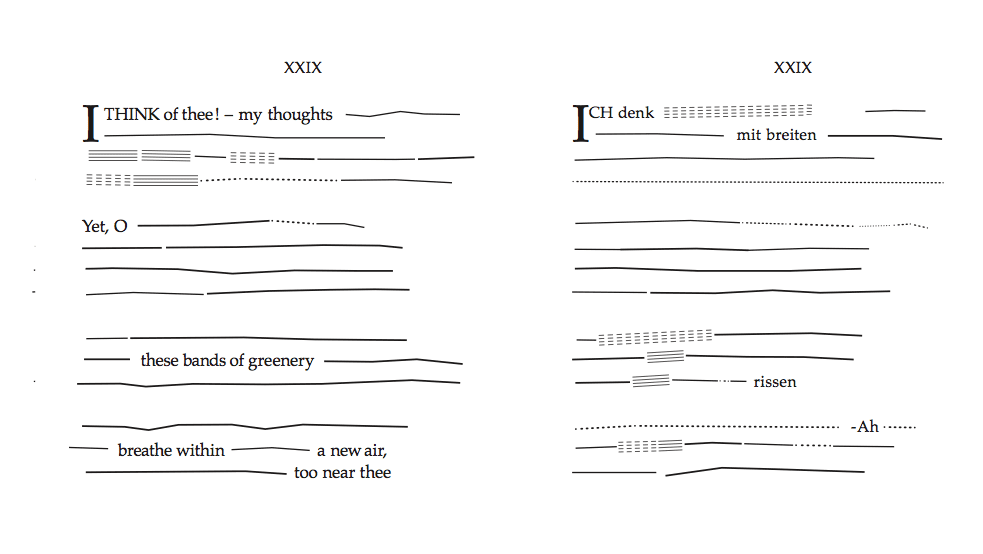
In Hawkey’s erasure, thoughts of the beloved are replaced by thoughts themselves; as a poet loves poetry, so too does cogitator love thinking. If the erasure turns on the original, it is only translating the volta already always formally native to the sonnet: “Yet, O” –the poem makes its turn, the original “bands of greenery” do not fall, shattered to the ground, but continue to “breathe within …. a new air, / too near thee.” Breathing in proximity is what these erasures want to do; their method is to breathe new air into Barrett Browning’s poems by lightening her rhetorical, figurative, and syntactic elaborations, stripping the poems to reveal a freshened body in love. Poetic finish becomes refinished.
Wolf follows, calling back to Hawkey, “I think / with broad / // torn // -Ah”. Where Hawkey erases Barrett Browning’s “shattering,” Wolf holds onto Rilke’s translation of it, “torn,” reflexively marking the textual tearing: Rilke’s translation of Barrett Browning’s “hear thee” — “Dich-Ahnen” (“sense thee”) — reverts to a lover’s sigh, “-Ah” — the act of reception is thereby translated into one of projection: and this double action, of reception & projection, is a great metaphor for translation, reenacted in this book.
How do I love thee? Let me count the ways… /// 1) Let me count the ways / when feeling / ends /// 2) Let me count / my // Lamps / or // all / my Saints. Addition through subtraction; call & response. Add in the fact that Hawkey and Wolf also translate each other’s poetry elsewhere, and the project of their erasure book seems more and more like a beautifully rendered conceptual work that, in some sense, is about marriage: between people, poetries, textuality, life. An exploration of distance, of closing and opening the gaps, that is also a recognition of ongoing relation. So, a new book of poems, very much of the present, always already founded in the past, looking forward, and suggesting how the language & form of poetry continue to change.
That it’s so rare to find a work of conceptual poetry that is also so satisfying to read, not just to talk about, says something about our situation. But with poets such as Christian Hawkey and Uljana Wolf thinking and talking about what’s possible in poetry, poetry continues to seem possible. Neither theory, nor fact, that’s just my hope – and hope for poetry is renewed only by poems, wherever we may find them.
— Joshua Weiner
